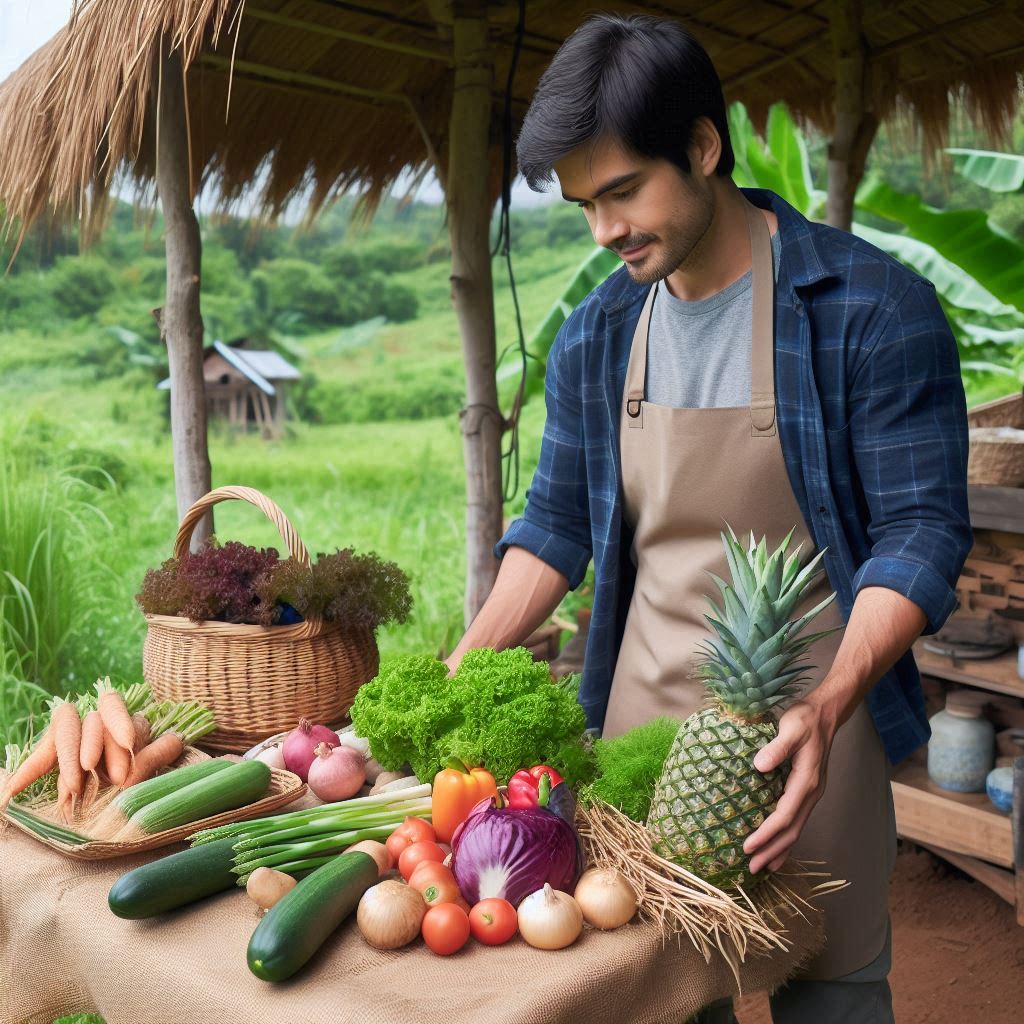Understanding Subsistence Farming
- Historical Background: Subsistence farming dates back to ancient times when families grew what they needed to survive. This practice was prevalent before the advent of industrial agriculture and the commercialization of farming. People relied on their land to provide food, clothing, and shelter, making subsistence farming an integral part of their daily lives.
- Modern Subsistence Farming Practices: Today, subsistence farming has evolved but still maintains its core principle: self-sufficiency. Modern subsistence farmers utilize contemporary techniques and tools while adhering to sustainable practices. This balance helps them meet their needs without depleting natural resources.
Benefits of Subsistence Farming
- Self-Sufficiency: Subsistence farming offers significant benefits for those seeking self-sufficiency. By producing their own food, farmers can reduce their reliance on external sources, ensuring a consistent and secure food supply for their families1. This practice not only enhances food security but also contributes to poverty alleviation, particularly in rural and marginalized communities2. Subsistence farmers often employ traditional, low-tech methods that prioritize environmental sustainability, helping to preserve soil fertility and reduce the use of harmful chemicals2. Additionally, this approach to farming allows families to continue living in rural areas where living expenses are generally lower, further contributing to their self-sufficiency3. By growing diverse crops and raising livestock, subsistence farmers can meet their nutritional needs year-round, reducing the need for purchased goods and fostering a deep connection to the land and traditional agricultural practices.
- Environmental Impact: Subsistence farming offers significant environmental benefits compared to industrial agriculture. This traditional farming method typically employs practices that are inherently more sustainable and eco-friendly. Subsistence farmers often use minimal chemical inputs, relying instead on natural pest control methods and organic fertilizers, which reduces pollution of soil and water resources1. The diverse crop rotations and intercropping systems commonly used in subsistence farming help maintain soil fertility, prevent erosion, and promote biodiversity6. Additionally, subsistence farming generally has a lower carbon footprint due to reduced mechanization and transportation needs. By cultivating a variety of crops adapted to local conditions, subsistence farmers also contribute to the preservation of agricultural biodiversity and the development of climate-resilient crop varieties5. These practices not only help mitigate environmental degradation but also enhance the resilience of agricultural ecosystems to climate change impacts.
- Economic Advantages: Subsistence farming offers significant economic advantages, particularly for rural and low-income communities. By producing their own food, farmers can substantially reduce their household expenses, as they no longer need to purchase most of their groceries3. This self-sufficiency can lead to improved financial stability and reduced vulnerability to market price fluctuations. Additionally, subsistence farmers often employ sustainable agricultural practices that eliminate the need for costly fertilizers and pesticides, further reducing their expenses3. In some cases, surplus produce can be sold at local markets or bartered with neighbors, providing a modest income stream or allowing farmers to obtain other necessary goods without monetary transactions3. Moreover, the diverse skill set developed through subsistence farming, such as carpentry, animal husbandry, and food preservation, can be leveraged to offer services to the local community, creating additional income opportunities.
Challenges in Subsistence Farming
- Resource Limitations: Subsistence farmers face significant challenges due to resource limitations. These farmers often operate with minimal capital, lacking access to modern agricultural tools, quality seeds, and fertilizers, which severely constrains their productivity1. Limited access to water resources is particularly problematic, as many subsistence farmers rely on rain-fed agriculture and struggle with unpredictable rainfall patterns2. In regions like China, water scarcity hits farmers hard, with competition from urban and industrial sectors further exacerbating the issue6. Additionally, subsistence farmers frequently work with small, scattered plots of land, which limits their ability to implement efficient farming techniques or achieve economies of scale1. The scarcity of resources often forces these farmers to rely on traditional, labor-intensive methods and unimproved crop varieties, resulting in low yields and perpetuating a cycle of poverty.
- Climate Changes: Climate change poses significant challenges to subsistence farmers, threatening their livelihoods and food security. Unpredictable weather patterns, including more frequent and severe droughts, floods, and heatwaves, can devastate crops and livestock, leading to reduced yields and potential crop failures13. These climate-induced impacts not only affect food production but also exacerbate soil erosion, decrease soil fertility, and alter the range of pests and diseases that farmers must contend with13. As a result, subsistence farmers, who are often the most vulnerable and least equipped to adapt, face increasing difficulties in maintaining their traditional farming practices and ensuring a stable food supply for their families and communities.
- Market Access: Subsistence farmers face significant challenges in accessing markets, which severely limits their economic opportunities. Many operate in remote areas with poor infrastructure, making it difficult and costly to transport their produce to urban centers or larger markets1. This isolation often forces farmers to rely on middlemen who pay low prices for their goods, reducing their potential income and perpetuating a cycle of poverty2. Additionally, subsistence farmers typically lack the resources and knowledge to meet quality standards or produce the quantities required by formal markets, further restricting their ability to participate in more lucrative agricultural value chains.
Planning Your Subsistence Farm
- Assessing Your Land: When planning your subsistence farming operation, assessing your land is a crucial first step. Begin by evaluating the soil quality through testing, which will help determine its fertility, pH levels, and nutrient content, guiding your decisions on crop selection and potential soil amendments1. Next, consider the topography and water resources of your land, as these factors will influence your farming methods, irrigation needs, and potential for soil erosion1. Assess the climate conditions, including rainfall patterns, temperature ranges, and growing season length, as these will significantly impact your crop choices and planting schedules5. Finally, take into account the size and layout of your available land, as this will determine the scale of your operation and the farming practices you can implement effectively.
- Determining Your Needs and Goals: When planning your subsistence farming operation, it’s crucial to clearly define your needs and goals. Start by assessing your family’s nutritional requirements and dietary preferences, which will guide your decisions on crop selection and livestock choices. Consider your long-term objectives, such as achieving complete self-sufficiency or potentially generating a small surplus for trade or sale. Finally, evaluate your available resources, including time, labor, and financial capacity, to ensure your farming plan aligns realistically with your capabilities and constraints.
Choosing the Right Crops
- Climate and Soil Considerations: Select crops that are well-suited to your local climate and soil conditions. This ensures better yields and reduces the risk of crop failure.
- Crop Diversity: Growing a variety of crops enhances food security and helps maintain soil health. It also provides a balanced diet and mitigates the risk of total crop loss due to pests or diseases.
Animal Husbandry in Subsistence Farming
- Selecting Livestock: Choose livestock that can thrive in your environment and meet your family’s needs. Chickens, goats, and rabbits are popular choices due to their relatively low maintenance and multiple uses.
- Sustainable Practices: Implement sustainable practices such as rotational grazing, composting manure, and providing adequate shelter to ensure the health and productivity of your animals.
Soil Health and Fertility
- Natural Fertilizers: Utilize natural fertilizers like compost and manure to enrich your soil. These organic materials provide essential nutrients and improve soil structure.
- Crop Rotation and Cover Crops: Practice crop rotation and plant cover crops to maintain soil fertility and prevent erosion. These methods also help control pests and diseases.
Water Management
- Irrigation Techniques: Efficient irrigation techniques, such as drip irrigation and mulching, help conserve water and ensure that crops receive adequate moisture.
- Rainwater Harvesting: Collecting and storing rainwater is a cost-effective way to supplement your water supply, especially in areas with limited rainfall.
Pest and Weed Control
- Organic Methods: Use organic pest control methods like neem oil, insecticidal soaps, and companion planting to protect your crops without harmful chemicals.
- Integrated Pest Management: Integrated Pest Management (IPM) combines biological, cultural, and mechanical methods to control pests effectively while minimizing environmental impact.
Harvesting and Storage
- Timing Your Harvest: Harvest crops at their peak maturity to ensure the best quality and nutritional value. Proper timing also helps avoid losses due to pests and weather conditions.
- Effective Storage Solutions: Invest in appropriate storage solutions, such as root cellars, drying racks, and canning supplies, to preserve your harvest and extend its shelf life.
Sustainability Practices
- Renewable Energy: Incorporate renewable energy sources like solar panels and wind turbines to power your farm operations and reduce reliance on non-renewable resources.
- Recycling and Composting: Practice recycling and composting to minimize waste and return valuable nutrients to the soil. This not only benefits your farm but also the environment.
Community and Subsistence Farming
- Sharing Resources: Collaborate with other local farmers to share resources, knowledge, and equipment. This fosters a sense of community and enhances productivity.
- Local Markets: Engage with local markets to sell or trade surplus produce. Building relationships with local consumers can provide a steady outlet for your farm products.
Overcoming Common Obstacles
- Financial Planning: Careful financial planning is essential to manage the costs of starting and maintaining a subsistence farm. Budgeting for seeds, tools, and other necessities helps ensure sustainability.
- Dealing with Natural Disasters: Develop contingency plans for natural disasters such as floods, droughts, and storms. Diversifying crops and building resilient infrastructure can mitigate potential damage.
Conclusion
Subsistence farming offers a pathway to a sustainable and self-sufficient lifestyle. By understanding the basics, planning carefully, and implementing sustainable practices, you can create a thriving subsistence farm that meets your needs and supports your community. The journey to self-sufficiency requires dedication and a willingness to learn, but the rewards are immense. Imagine the satisfaction of harvesting fresh produce from your own garden, knowing that it is free from harmful chemicals and full of nutrients.
Beyond the practical benefits, subsistence farming fosters a deeper connection to the land, promoting a sense of stewardship and responsibility for the environment. Each step you take towards self-sufficiency—whether it’s planting a new crop, building a compost system, or learning to can your vegetables—brings you closer to a more fulfilling and sustainable way of life.
Embrace the journey and enjoy the rewards of growing your own food and living in harmony with nature. As you develop your subsistence farm, you will find that the skills and knowledge you acquire are invaluable. From understanding the intricacies of soil health to mastering the art of preserving food, these skills not only enhance your self-reliance but also contribute to a resilient and sustainable community. Sharing your experiences and produce with neighbors can build stronger local networks and promote a culture of sustainability.
Moreover, subsistence farming can be a source of immense personal fulfillment and joy. Watching your plants grow, caring for your livestock, and tasting the fruits of your labor are deeply rewarding experiences that reconnect you with the natural world. In a fast-paced, technology-driven world, subsistence farming offers a peaceful, meaningful counterbalance—a way to slow down, appreciate the simple pleasures of life, and cultivate a more sustainable future for yourself and future generations.
FAQs (Frequently Asked Questions)
Q1: What is the best crop for beginners in subsistence farming?
Answer: For beginners, crops like potatoes, carrots, and beans are easy to grow and provide good yields. They are also versatile in the kitchen.
Q2: How much land do I need for a subsistence farm?
Answer: The amount of land needed depends on your goals and the number of people you need to feed. Generally, 1 to 5 acres can support a small family.
Q3: What are some cost-effective ways to start subsistence farming?
Answer: Start small, use recycled materials for building structures, and learn to compost to reduce the need for chemical fertilizers.
Q4: How can I ensure my subsistence farm is sustainable?
Answer: Implement practices like crop rotation, organic farming, water conservation, and renewable energy to maintain sustainability.
Q5: What resources are available for new subsistence farmers?
Answer: Local agricultural extensions, community colleges, and online forums offer valuable resources and support for new subsistence farmers.
Q6: What are some common pests in subsistence farming and how can I control them organically?
Answer: Common pests include aphids, beetles, and caterpillars. You can control them organically using methods like introducing beneficial insects (e.g., ladybugs), using neem oil, and practicing companion planting to deter pests.
Q7: How can I improve soil fertility without using chemical fertilizers?
Answer: Improving soil fertility can be achieved by adding organic matter such as compost and manure, practicing crop rotation, using cover crops, and applying green manure. These methods enhance soil structure and nutrient content naturally.
Q8: What types of livestock are best for small-scale subsistence farming?
Answer: Chickens, goats, rabbits, and bees are ideal for small-scale subsistence farming. They require less space, provide multiple benefits (eggs, milk, meat, honey), and can be managed sustainably with minimal resources.
Q9: How can I manage water scarcity on my subsistence farm?
Answer: To manage water scarcity, implement efficient irrigation methods like drip irrigation, mulch your crops to retain soil moisture, practice rainwater harvesting, and choose drought-resistant crop varieties.
Q10: What are the best practices for storing harvested crops to prevent spoilage?
Answer: Store harvested crops in cool, dry, and dark places. Use methods like canning, drying, freezing, and fermenting to preserve food. Ensure proper ventilation and humidity control in storage areas to prevent mold and rot.







